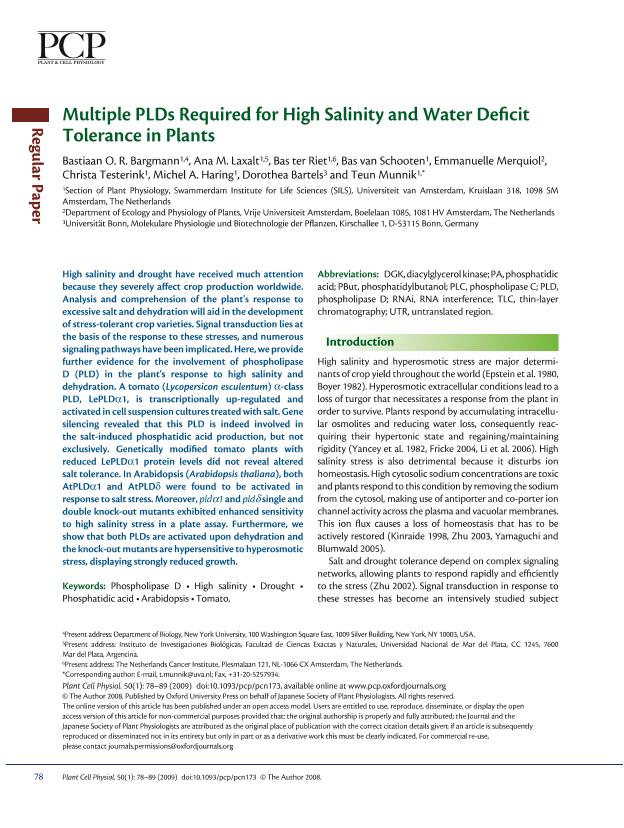Mostrar el registro sencillo del ítem
dc.contributor.author
Bargmann, Bastiaan O. R.
dc.contributor.author
Laxalt, Ana Maria

dc.contributor.author
Riet, Bas ter
dc.contributor.author
van Schooten, Bas
dc.contributor.author
Merquiol, Emmanuelle
dc.contributor.author
Testerink, Christa
dc.contributor.author
Haring, Michel A.
dc.contributor.author
Bartels, Dorothea
dc.contributor.author
Munnik, Teun
dc.date.available
2020-05-14T16:09:34Z
dc.date.issued
2008-11
dc.identifier.citation
Bargmann, Bastiaan O. R.; Laxalt, Ana Maria; Riet, Bas ter; van Schooten, Bas; Merquiol, Emmanuelle; et al.; Multiple PLDs Required for High Salinity and Water Deficit Tolerance in Plants; Oxford University Press; Plant And Cell Physiology; 50; 1; 11-2008; 78-89
dc.identifier.issn
0032-0781
dc.identifier.uri
http://hdl.handle.net/11336/105127
dc.description.abstract
High salinity and drought have received much attention because they severely affect crop production worldwide. Analysis and comprehension of the plant's response to excessive salt and dehydration will aid in the development of stress-tolerant crop varieties. Signal transduction lies at the basis of the response to these stresses, and numerous signaling pathways have been implicated. Here, we provide further evidence for the involvement of phospholipase D (PLD) in the plant's response to high salinity and dehydration. A tomato ( Lycopersicon esculentum ) α -class PLD, LePLD α 1, is transcriptionally up-regulated and activated in cell suspension cultures treated with salt. Gene silencing revealed that this PLD is indeed involved in the salt-induced phosphatidic acid production, but not exclusively. Genetically modifi ed tomato plants with reduced LePLD α 1 protein levels did not reveal altered salt tolerance. In Arabidopsis ( Arabidopsis thaliana ), both AtPLD α 1 and AtPLD δ were found to be activated in response to salt stress. Moreover, pldα1 and pldδ single and double knock-out mutants exhibited enhanced sensitivity to high salinity stress in a plate assay. Furthermore, we show that both PLDs are activated upon dehydration and the knock-out mutants are hypersensitive to hyperosmotic stress, displaying strongly reduced growth.
dc.format
application/pdf
dc.language.iso
eng
dc.publisher
Oxford University Press

dc.rights
info:eu-repo/semantics/openAccess
dc.rights.uri
https://creativecommons.org/licenses/by-nc-sa/2.5/ar/
dc.subject
phospholipase D
dc.subject
salt stress
dc.subject.classification
Biología Celular, Microbiología

dc.subject.classification
Ciencias Biológicas

dc.subject.classification
CIENCIAS NATURALES Y EXACTAS

dc.title
Multiple PLDs Required for High Salinity and Water Deficit Tolerance in Plants
dc.type
info:eu-repo/semantics/article
dc.type
info:ar-repo/semantics/artículo
dc.type
info:eu-repo/semantics/publishedVersion
dc.date.updated
2020-05-05T16:11:00Z
dc.journal.volume
50
dc.journal.number
1
dc.journal.pagination
78-89
dc.journal.pais
Reino Unido

dc.journal.ciudad
Oxford
dc.description.fil
Fil: Bargmann, Bastiaan O. R.. Universiteit van Amsterdam; Países Bajos
dc.description.fil
Fil: Laxalt, Ana Maria. Consejo Nacional de Investigaciones Científicas y Técnicas; Argentina. Universiteit van Amsterdam; Países Bajos
dc.description.fil
Fil: Riet, Bas ter. Universiteit van Amsterdam; Países Bajos
dc.description.fil
Fil: van Schooten, Bas. Universiteit van Amsterdam; Países Bajos
dc.description.fil
Fil: Merquiol, Emmanuelle. Vrije Universiteit Amsterdam.; Países Bajos
dc.description.fil
Fil: Testerink, Christa. Universiteit van Amsterdam; Países Bajos
dc.description.fil
Fil: Haring, Michel A.. Universiteit van Amsterdam; Países Bajos
dc.description.fil
Fil: Bartels, Dorothea. Universität Bonn; Alemania
dc.description.fil
Fil: Munnik, Teun. Universiteit van Amsterdam; Países Bajos
dc.journal.title
Plant And Cell Physiology

dc.relation.alternativeid
info:eu-repo/semantics/altIdentifier/doi/http://dx.doi.org/10.1093/pcp/pcn173
dc.relation.alternativeid
info:eu-repo/semantics/altIdentifier/url/https://academic.oup.com/pcp/article/50/1/78/1849628
Archivos asociados
